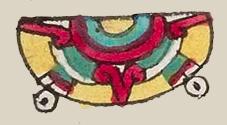teotl (Mdz46r)
This element has been carved from the compound sign for the place name, Teotlilan. It is half a sun disc, with multiple colors, smaller circles, and points.
Stephanie Wood
See our record for tonatiuh (sun, day) in order to compare this half disc with a full disc. The half disc is used regularly in the glyphs of the Codex Mendoza to represent the phonetic sound "teo" and a meaning of divine force(s), sun, and calendrics. Magnus Pharao Hansen and Christophe Helmke have pointed out that it is usually the upper half of the sun sign that is used for teo-. Here we see one of the exceptions to that generality.
For further discussion of teotl and tonatiuh, see the work of Hansen and Helmke in Contributions to New World Archaeology, v. 13 (Kraków, 2019).
Stephanie Wood
c. 1541, but by 1553 at the latest
Stephanie Wood

teo(tl), divine force(s), https://nahuatl.wired-humanities.org/content/teotl
las fuerzas sagradas, la deidad, el sol
Stephanie Wood
Codex Mendoza, folio 46 recto, https://digital.bodleian.ox.ac.uk/objects/2fea788e-2aa2-4f08-b6d9-648c00..., image 102 of 188.
The Bodleian Libraries, University of Oxford, hold the original manuscript, the MS. Arch. Selden. A. 1. This image is published here under the UK Creative Commons, “Attribution-NonCommercial-ShareAlike 3.0 License” (CC-BY-NC-SA 3.0).


